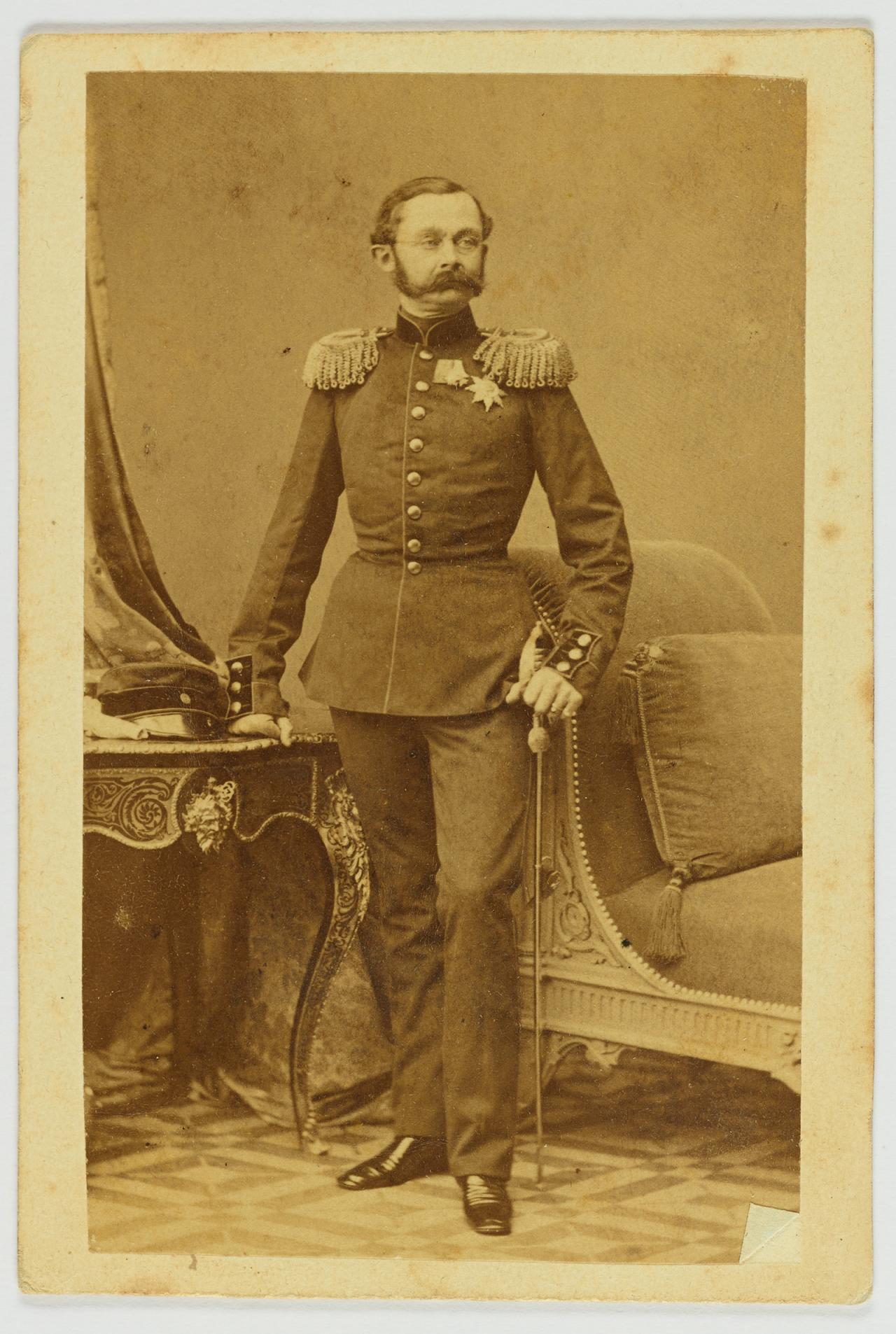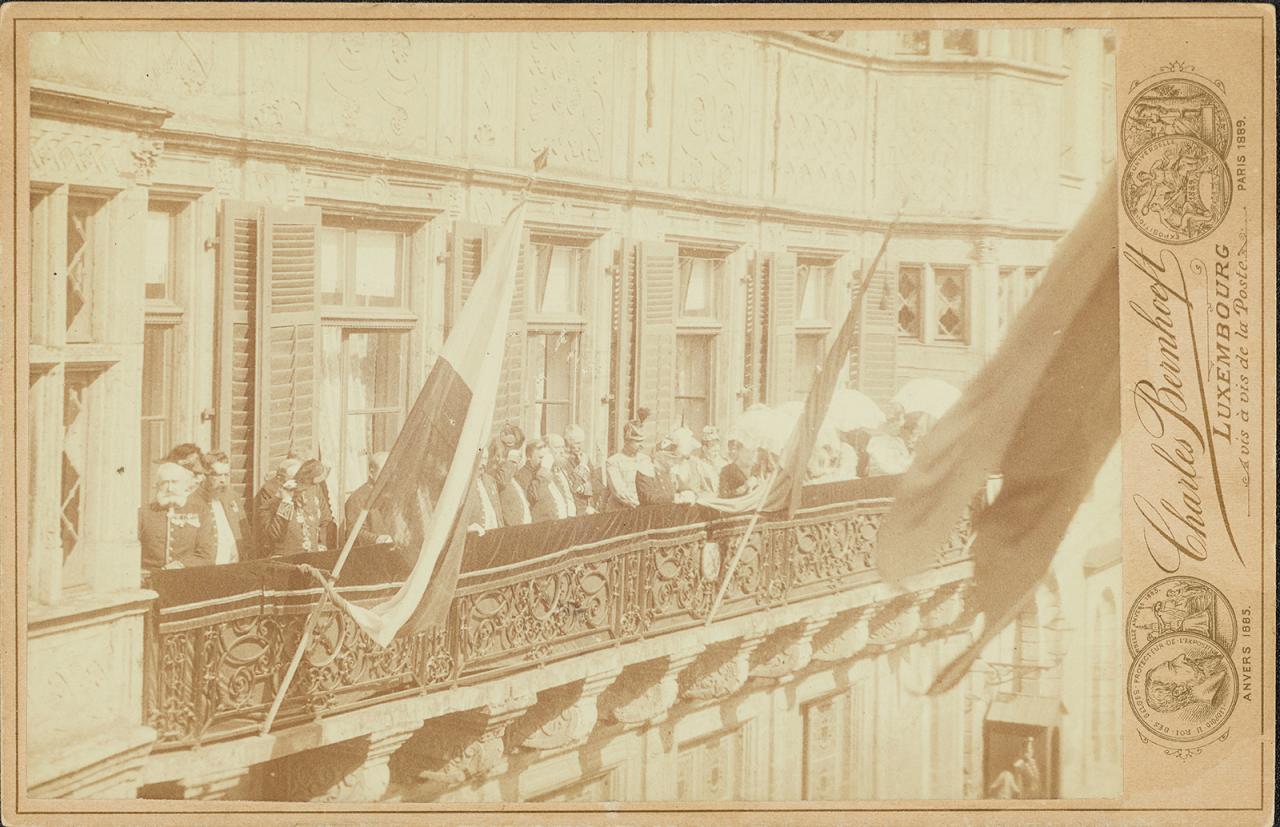
H.R.H. Grand Duke Adolphe
Born on 24 July 1817
in Biebrich on the Rhine, Germany
Biography
His reign was characterised by his respect for the Constitution and institutions, his patronage and his charitable works. Monuments in Weilburg, Königstein and Luxembourg perpetuate the memory of a sovereign who reconciled tradition and modernity.
Adolphe, future Grand Duke of Luxembourg and Duke of Nassau, was born on 24 July 1817 at Biebrich Palace in the Duchy of Nassau. He was the eldest son of Duke Wilhelm and his wife, Duchess Louise of Saxe-Hildburghausen. His first names - Adolphe Wilhelm Carl August Friedrich – evoke the Walramian line of the House of Nassau and the reign of King Adolphe of Nassau (1292-1298), affirming his royal ancestry from birth.
Married to
Children

Woodcut portrait of Grand Duke Adolphe in 1890
Collections de la Maison grand-ducale, © Maison du Grand-Duc
Youth and education
The young Prince Adolphe spent his childhood in the privacy of Biebrich Palace, where, along with his siblings Thérèse (1815), Maurice (1820) and Marie (1825), he was educated in strict accordance with court etiquette.

Source : Collection photographique de la Maison grand-ducale
After the premature death of Duchess Louise in 1825, Duke Wilhelm appointed Georg Lorberg and Christoph Resius as tutors, soon joined by Edmond Milne for French lessons. The curriculum included classical languages, history, geography, mathematics and military science, adding up to approximately twenty-six hours of lessons per week.
Between 1826 and 1832, his teachers' reports highlighted Adolphe's quick wit and his remarkable progress in Latin translation and geometry from the age of eleven. Excursions along the Rhine and swimming and gymnastics lessons strengthened his physical vigour.
In December 1828, Duke Wilhelm entered into a second marriage with Princess Pauline of Württemberg. The Duchess gave birth to four children, three of whom survived: Hélène (1831), Nicolas (1832) and Sophie (1836), the future Queen of Sweden and Norway. Educational reforms were introduced in 1829 by Philippe Leyendecker: he gave mathematics lessons in small groups, which boosted Prince Adolphe's motivation and confidence. The introduction of music and trips to the theatre awakened his taste for the arts.
Adolescence and studies
From 1832 onwards, Major Heinrich von Hadeln supervised the military and protocol training of Princes Adolphe and Maurice. At the end of this training, Adolphe was promoted to first lieutenant in 1835.

Portrait of Duke Adolphe of Nassau
© Collection Cour grand-ducale
He then took part in Austrian and Nassau manoeuvres, during which his riding skills and sense of discipline were praised. His school curriculum was enriched with new subjects: he now also studied English, Greek and German literature and wrote historical essays. In November 1836, he completed his schooling, demonstrating diligence, a sense of responsibility and an interest in public affairs, according to his teachers' comments.

Source : Collection photographique de la Maison grand-ducale
On the recommendation of the lawyer Carl Jarcke, Princes Adolphe and Maurice began eighteen months of private lessons in Vienna in January 1837. Despite the many distractions offered by court audiences, the imperial theatre and aristocratic salons, their teachers praised their diligence. Their curriculum included practical exercises (fortifications, weapon handling), music lessons and excursions. During a second session in Vienna (October 1837 to mid-1838), the future Duke Adolphe acquired, among other things, a perfect command of French.
Grand Tour and accession to the throne
In June 1838, Crown Prince Adolphe accompanied his father, Duke Wilhelm of Nassau, to England for the coronation of Queen Victoria. During this trip, he observed British parliamentary traditions and established diplomatic relations. Their itinerary then took them to The Hague and Bad Ems, where they had the opportunity to strengthen ties with the Dutch and German courts. On his return to Weilburg, Duke Wilhelm suffered a stroke and died unexpectedly on 20 August 1839. At only 22 years of age, Prince Adolphe inherited the Duchy of Nassau.
Marriages and domestic politics
In the early years of his reign, Duke Adolphe devoted himself more to hunting and horse riding. Despite his jovial nature, he was known to be unreceptive to the advice of his ministers and proved to be very conservative.
Nonetheless, his reign was marked by the modernisation of the Duchy, with the construction of railway lines and the development of thermal spas in Wiesbaden, which contributed to its economic growth.

Source : Collection photographique de la Maison grand-ducale
In 1844, Adolphe married Grand Duchess Elisabeth Mikhailovna of Russia. She died a year later while giving birth to a premature baby girl who did not survive. Deeply affected by this loss, Duke Adolphe had the Orthodox Church of St. Elisabeth built in her memory on the heights of Wiesbaden, which became their burial place.
In 1851, he married Princess Adelheid Marie of Anhalt-Dessau. The couple had five children, only two of whom reached adulthood: Prince William (1852-1912), who later reigned over Luxembourg, and Princess Hilda (1864-1952), future Grand Duchess of Baden.

Postcard from 1901 celebrating the Golden Wedding of TT.RR.HH: Grand Duke Adolphe of Luxembourg and Grand Duchess Adelheid Marie. The four medallions contain painted and photographic portraits of Grand Duke Adolphe and his wife.
© Collection Cour grand-ducale
The revolutionary wave of February-March 1848 confronted Adolphe with the 'nine demands of the Nassovians,' which expressed the liberal aspirations of the citizens, including a democratic constitution, freedom of the press, equality before the law, and an elected national representation. Then staying in Berlin, Duke Adolphe of Nassau hurried back to Wiesbaden, where a crowd of nearly 40,000 people had gathered in front of the ducal palace. On 4 March, from the palace balcony, he promised reforms and, with a peaceful gesture, ended the crisis without bloodshed. He initiated a constitutional revision unprecedented among the German states.
In his diary, he confided his emotion at renouncing his prerogatives as an absolute monarch, while affirming the renewed bond between sovereign and subjects.
After 1848, Adolphe had to negotiate the terms of the reforms with a predominantly liberal Assembly, while preserving his dynastic interests. Opposed to Prussian hegemony, he also favoured Austrian influence in federal affairs. The financial compromise of 1861 partially separated his private estates from the state budget, but tension with liberal deputies persisted. At the same time, his patronage transformed Wiesbaden, which grew from 11,000 inhabitants in 1815 to 27,000 in 1866, thanks to new neoclassical buildings, public gardens and civic institutions.
Loss of the Duchy of Nassau, exile and compensation
In 1866, the Austro-Prussian conflict over the two duchies of Schleswig and Holstein drew the Duchy of Nassau into the war.
Loyal to the German Confederation, Duke Adolphe mobilised his troops behind the Habsburgs of Austria. The defeat at Königgrätz and the rapid advance of the Prussians made resistance futile, despite the fighting spirit of the Nassau brigade. The occupation of Wiesbaden by Prussian troops on 18 July forced the sovereign into exile; the Duchy of Nassau was annexed without a plebiscite by Prussia on 7 September.
Adolphe then negotiated the loss of his title of Duke and his sovereignty over the Duchy of Nassau in exchange for 15 million guilders in Prussian bonds and the retention of his private estates, thus preserving his financial security.

Source : Collection photographique de la Maison grand-ducale
Residing successively in Rumpenheim, Königstein and Vienna, Adolphe maintained a court of more than 140 people and devoted himself to philanthropy, notably supporting Nassau veterans of the Austro-Prussian War.
The 1867 treaty he signed with Prussia guaranteed him an income equivalent to his former court budget, which - in addition to retaining his former palaces - enabled him to acquire Hohenburg Castle near Lenggries in Bavaria in 1870.
Accession to the throne of Luxembourg
In April 1889, Adolphe arrived in Luxembourg as regent for King William III of the Netherlands, who was seriously ill at the time.
His arrival caused quite a stir among the Luxembourgish population: dressed in his Nassau uniform and wearing a helmet reminiscent of the spiked helmets worn by Prussian soldiers, he revived sensitive and sometimes painful memories of the Prussian garrison in the former federal fortress.
Despite this initial misstep, Adolphe quickly established himself as a regent who was attentive to local customs. He kept out of government affairs and left it to Minister of State Paul Eyschen to run the country in accordance with the institutions.

Swearing-in of Duke Adolphe of Nassau as Duke-Regent.
© Collection Cour grand-ducale
The bond he forged with Luxembourg was strengthened during a second period of regency in 1890, in the weeks leading up to the death of William III, the last Nassau of the Ottonian branch. Upon his death, the order of succession provided for in the Family Pact of 1783 came into force, making Adolphe and the Walramian branch of the Nassau dynasty the new heirs to the Grand Ducal throne. During his swearing-in speech, Grand Duke Adolphe declared in words that have gone down in history:
From today, I am a Luxembourger like you, gentlemen, a Luxembourger in heart and soul.
H.R.H. Grand Duke Adolphe

Photograph of H.R.H. Grand Duke Adolphe on the balcony of the Grand Ducal Palace in 1896
© Collection Cour grand-ducale

1890: Photo of the Grand Ducal Family on the balcony of the Grand Ducal Palace
© Collection Cour grand-ducale
Once he became Grand Duke of Luxembourg, Adolphe continued to reside abroad for much of the year. This worried the Luxembourgish population, who wanted to see the new Grand Duke settle permanently in the Grand Duchy. However, the new sovereign divided his time between his residences in Königstein and Hohenburg, and regularly stayed on the Italian coast in Abbazia and Santa Margherita, where the climate was milder and more favourable to the health of a 73-year-old man.
Nevertheless, aware that the new dynasty must establish itself in Luxembourg, Grand Duke Adolphe launched an ambitious project in 1891 to transform the former Town Hall into a palace worthy of housing the Grand Ducal family. The modernisation and extension work was entrusted to the Brussels architect Gédéon Bordiau, who had already worked for Grand Duke Adolphe in Königstein, assisted by the Luxembourg state architect Charles Arendt. Grand Duke Adolphe subsequently made Berg Castle available to his son, Hereditary Grand Duke William, so that he could settle there with his family.

Source : Collection photographique de la Maison grand-ducale
Private life and final years
Throughout his life, Grand Duke Adolphe was passionate about sports and hunting. At the age of 77, he introduced skating and skiing to his Bavarian estates. He was also renowned as a fearless horseman who rode swiftly through the parks along the Pétrusse in Luxembourg.

Engraved photo of Duke Adolphe of Nassau in military uniform
© Private collection / Cour grand-ducale
Grand Duke Adolphe died on 17 November 1905 at Hohenburg Castle, where he had retired, and a national tribute was paid to him in Luxembourg. He was initially buried in the castle forest, in a simple monument, alongside the remains of his children who had died prematurely. In 1953, his coffin was transferred to the Sovereign crypt of Weilburg, the family tomb of the Protestant members of the House of Nassau.
His reign was characterised by his respect for the Constitution and institutions, his patronage and his charitable works. Monuments in Weilburg, Königstein and Luxembourg perpetuate the memory of a sovereign who reconciled tradition and modernity.









